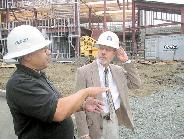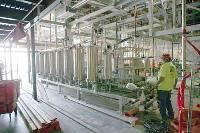November 14, 2006
$5.1 MILLION TO FUND AG HEALTH AND SAFETY CENTER AT UC DAVIS
The University of California, Davis', Western Center for Agricultural Health and Safety has received $5.1 million from the National Institute for Occupational Safety and Health to continue the center's research and education efforts for the next five years.
Founded in 1990, it is one of nine agricultural health and safety centers established by the federal Centers for Disease Control and Prevention to improve health and safety for the nation's farmers, farmworkers and consumers.
"This renewal of funding represents not only financial support, but also a vote of confidence in the center's established record in addressing the agricultural health and safety challenges of California and the Western United States," said Marc Schenker, director of the UC Davis center.
"As the nation's leading agricultural state, California, alone, is home to a broad spectrum of agricultural enterprises ranging from family farms to large corporate operations, which employ family members, farmworkers and laborers from a variety of countries and cultures," Schenker noted. "Addressing the health and safety needs of this very large, multifaceted industry is no small task."
The new federal grant enables the center to continue its wide-ranging research and education projects and to investigate new areas of concern. In addition to conducting research and developing educational programs related to disease- and injury-prevention, the center works to develop effective collaborations among colleges and universities, government agencies, industry and community groups.
Current research highlights include projects focused on airborne particles, the health and safety of farmworkers and their families, and respiratory health of dairy workers:
* Airborne particles -- Dry farming techniques used in California's Central Valley result in high levels of airborne particles produced by a variety of farming activities including field preparation, stubble burning and harvesting. Kent Pinkerton, a UC Davis professor of veterinary medicine, and director of the Center for Health and the Environment, is working with colleagues to study the health effects associated with airborne agricultural particles by performing animal inhalation studies at agricultural sites. He also is conducting a study in the community of Parlier near Fresno, Calif., to examine the acute health effects of airborne particles. Ninety-seven percent of Parlier's residents are Hispanic, and almost all are connected to agriculture.
* Farmworker health -- In a second study, known as the MICASA (Mexican Immigration to California: Agricultural Safety and
Acculturation) project, researchers are investigating how to best prevent occupational diseases and injuries among hired farmworkers and their families. The research team will conduct interviews with approximately 400 Hispanic farmworker families who live in the Central Valley community of Mendota, Calif. They also will develop and implement educational programs to serve these residents. In collaboration with the UC San Francisco School of Dentistry, this project will also provide oral health exams for women and children in the study group. Led by Marc Schenker and field coordinator Kathleen O'Connor, the study will focus on occupational risk factors and health behaviors, evaluate the respiratory function of hired farm workers, and examine factors that increase the risk of certain health problems in Latino children.
* Dairy worker health -- Large dairies housing more than 2,000 cows have been rapidly increasing in number in the Central Valley. On most California dairies, the cows live in open-sided free stalls or corrals. They stand on dried manure, or their excrement is flushed away to a holding pond. The workers on the dairies may breathe many different particles in the air, including particles from mineral soils, pulverized manure, airborne feed and fragments of bacteria.
This study, led by Frank Mitloehner, a Cooperative Extension air quality specialist from UC Davis' animal science department, will be the first California health investigation to look specifically at current dairy practices and determine the amounts of material dairy workers are exposed to over the course of a work shift. Approximately 20 large dairies in Tulare and Merced counties -- the two San Joaquin Valley counties with the most dairies -- will be monitored
More information about these research projects and other activities of the Western Center for Agricultural Health and Safety is available online at
Media contact(s):
* Sandy Freeland, Western Center for Agricultural Health and Safety,
(530) 752-4050, slfreeland@ucdavis.edu
* Pat Bailey, UC Davis News Service, (530) 752-9843, pjbailey@ucdavis.edu
------------------------------------------------
Our full UC Davis directory of media services and 24-hour contact information is available at
------------------------------------------------
Need information from campus news archives? The UC Davis News Service database contains past (and current) UC Davis news stories dating to 1991. Go to
-------------------------------------------------
More university news and an experts directory:
-------------------------------------------------
To unsubscribe, please send an e-mail message to newsservice@ucdavis.edu.
-------------------------------------------------
UC Davis News Service
One Shields Avenue
Davis, California 95616-8687
newsservice@ucdavis.edu
Phone: (530) 752-1930; Fax: (530) 752-4068






